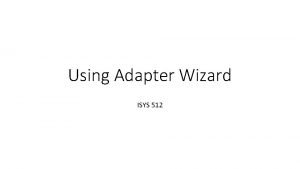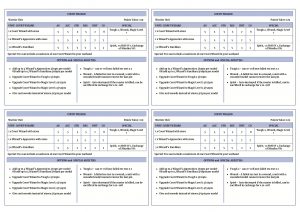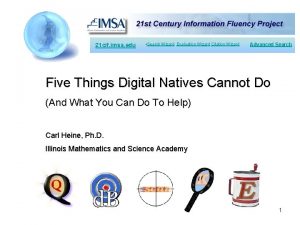Grid Wizard Enterprise http www gridwizardenterprise org GWE
















- Slides: 16

Grid Wizard Enterprise (http: //www. gridwizardenterprise. org) GWE Core National Alliance for Medical Image Computing (NA-MIC - http: //namic. org) Biomedical Informatics Research Network (BIRN http: //nbirn. net)

Context: Computing Needs Overview 1. 2. Requirements for computing increasing fast. Main reasons: • More data to process. • More compute intensive algorithms available. Approaches to supply demand: • Qualitative: Optimized algorithms, faster processors, more memory. • Quantitative: Cluster computing, grid computing, etc.

Grid Architecture: Clusters & Resource Managers • Cluster Operating System: Example: Rocks. • Network. • Head Node: Dedicated compute resource hosting cluster level services. • Compute Nodes. • File System: Networked file system accessible by any node in the cluster (independent from other file system nodes may have access to). • Resource Manager: Optional front end software component to manage and execute cluster “jobs”. Example: Condor, SGE, PBS, Torque, LSF, etc.

Grid Architecture: The Grid • Collection of Clusters. • Grid “Client” is responsible to provide the logic to integrate the clusters within the logic of their specific applications. • This effort is non-trivial, non-reusable, non-extensible, lacks robustness and is far from giving the end user all the desired functionality.

Grid Architecture: “Meta Scheduler” enabled Grid • An approach to integrate clusters using a single front end system. “Resource Manager” to “uniform interface” translation systems. • Samples: Globus “Grid. Way”, Globus ‘CSF”, “Grid Wizard”

Grid Architecture: “Meta Scheduler” enabled Grid • Pros: Simple and straight forward solution. • Cons: No granular control, depends on resource manager to execute anything on the cluster.

GWE: Introduction • Why? Because the grid computing has not been streamlined yet. • Open source distributed enterprise java based system. • Objective: Ease all tasks related to the effort to parallel execute interindependent processes across clusters. • Collection of autonomous back end applications running in clusters head and compute nodes. • Extremely easy integration, installation and usage. • Provides single view to clusters and/or grid. • Provides lots of granular control and features to grid “client”s. • Provides auto configuration with most sensible and auto discovered values to minimize user input. • Technology Requirements: SSH enabled clusters, Java 1. 5.

GWE: Internal Components Interfaces • To cluster components. Built on top of drivers framework. New drivers can be easily plug for specific components not yet supported. • To other distributed GWE systems.

GWE: GWE Enabled Cluster • Tight integration with cluster internals and transparent access to them. • Granular level of execution control: submission, pause, resume, abort. • Real time monitoring and alerting capabilities.

GWE: GWE Enabled Cluster • Granular reporting of historic, diagnostics and statistics data. • Transparent environment translation for requests. • Programmatic control with rich and simple API.

GWE: Distributed System • “GWE Cluster Components” (GWE daemons) are designed to interface with each other in topologies customizable by the end user.

GWE: GWE Enabled Grid • Once a GWE client logs into a GWE daemon it is able to control the respective cluster, get a unified view of a grid and gain access to all the services GWE provides over such grid.

GWE: Architecture Overview

GWE: Architecture Overview

GWE: Tool Integration • GWE comes with a robust, flexible, full featured programmatic API to access “GWE Grid”s services. • API communicates with “GWE Grid”s using RMI RPC over secured SSH Tunnels. • GWE includes generic command line tools to access “GWE Grid”s services. These tools have been built using the API.

GWE: More Information • Project site with a great wealth of information including detailed guides and GWE’s source code: http: //www. gridwizardenterprise. org/ • Users mailing list to receive project news and announcements: gwe-users@nbirn. net • Particular questions, requests and feedback you may want to share: gwe-support@nbirn. net Thanks!
 Va wizard.org
Va wizard.org North bridge south bridge
North bridge south bridge Putting the enterprise into the enterprise system
Putting the enterprise into the enterprise system Enterprise
Enterprise Www.grid.org
Www.grid.org Http //mbs.meb.gov.tr/ http //www.alantercihleri.com
Http //mbs.meb.gov.tr/ http //www.alantercihleri.com Http //siat.ung.ac.id atau http //pmb.ung.ac.id
Http //siat.ung.ac.id atau http //pmb.ung.ac.id Http://mbgnet.mobot.org/
Http://mbgnet.mobot.org/ Http//oh.portal.airast.org
Http//oh.portal.airast.org Ets.criterion
Ets.criterion Http://www.caaspp.org
Http://www.caaspp.org Http://hdr.undp.org/en/data
Http://hdr.undp.org/en/data Http://www.pbs.org/ktca/liberty/
Http://www.pbs.org/ktca/liberty/ Lääne siberi lauskmaa
Lääne siberi lauskmaa Http://www.caaspp.org
Http://www.caaspp.org Http://pisa.ets.org/school
Http://pisa.ets.org/school Www.python
Www.python































